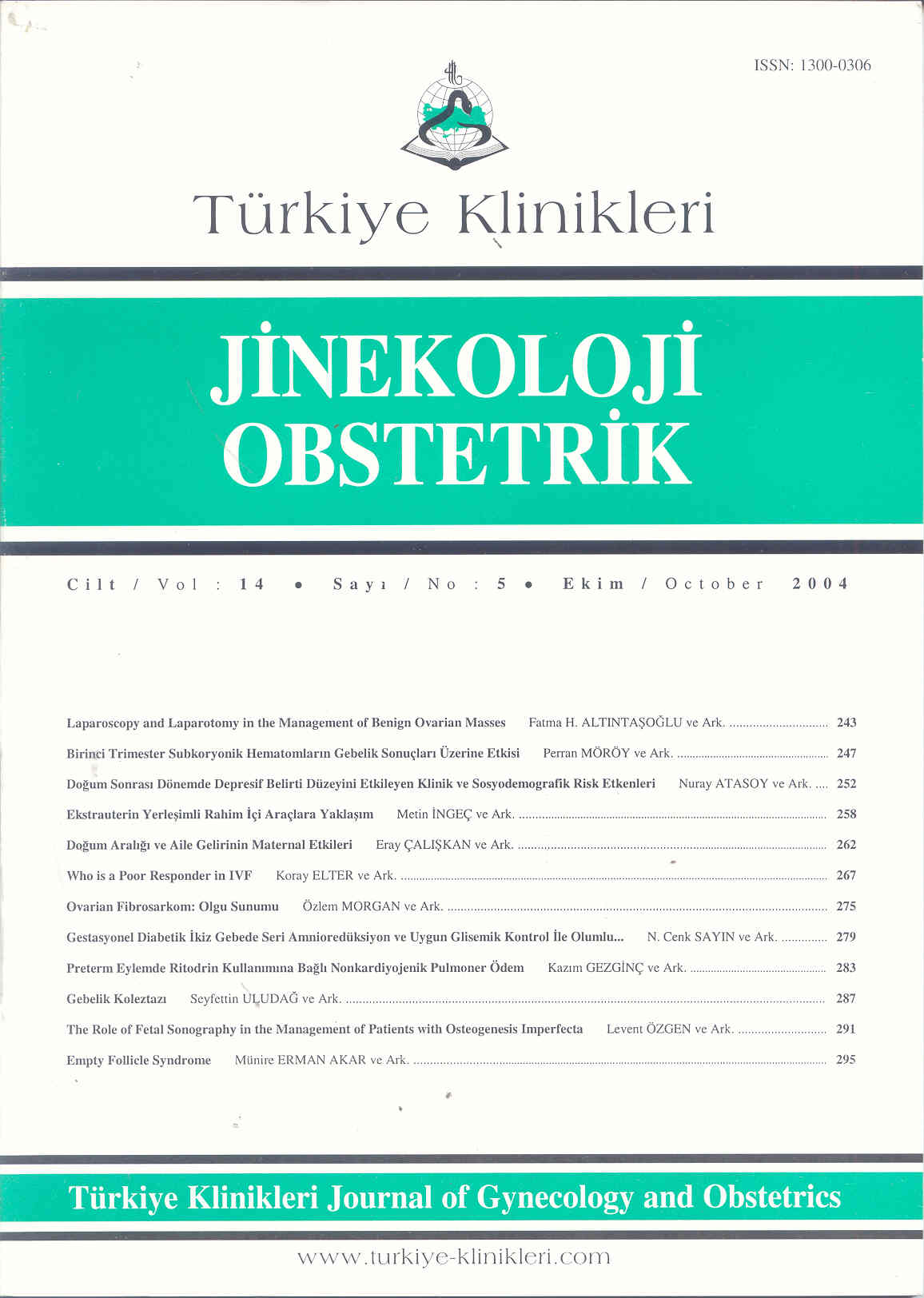Open Access
Peer Reviewed
ORIGINAL RESEARCH
6772 Viewed3530 Downloaded
The Effects Of First Trimester Subchorionic Hematomas On Pregnancy Outcome
Birinci Trimester Subkoryonik Hematomların Gebelik Sonuçları Üzerine Etkisi
Turkiye Klinikleri J Gynecol Obst. 2004;14(5):247-51
Article Language: TR
Copyright Ⓒ 2025 by Türkiye Klinikleri. This is an open access article under the CC BY-NC-ND license (http://creativecommons.org/licenses/by-nc-nd/4.0/)
ÖZET
Amaç: Birinci trimesterde subkoryonik hematom (SKH) saptanan hastalarda hematom büyüklüğünün, lokalizasyonunun, saptandığı haftanın ve maternal yaşın gebelik sonuçlarına etkilerini belirlemek. Gereç ve Yöntemler: Gebeliğinin ilk trimesterinde vajinal kanaması olan ve ultrasonografide intrauterin tek, canlı gebelikle beraber subkoryonik hematom izlenen 82 hasta prospektif olarak incelendi. Hastaların yaşları, gebelik haftaları, gestasyonel kese boyutları ile hematom lokalizasyonları ve büyüklükleri kaydedildi. Hematom büyüklükleri, diseke olan koryonik membran uzunluğunun, koryonik sac çevresine oranlanmasına göre belirlenerek iki gruba ayrıldı(1/3-1/2 grup 1; 2/3 ve üzeri grup 2). Hastalar 20. haftaya kadar takip edildi. Bulgular: Takip edilen 82 hastada spontan abort oranı %32 olarak saptandı. Gebelik haftalarına göre 24 olgunun (% 29) 8 hafta ve altında, 58 olgunun (%70) 8 hafta üzerinde olduğu bulundu. Subkoryonik hematom büyüklüğüne göre değerlendirildiğinde, Grup 2deki abort oranının Grup 1e oranla istatistiksel olarak anlamlı derecede yüksek olduğu izlendi (sırasıyla, %70 %19, p: 0.002). Bu olgularda spontan abort rölatif riskinin yaklaşık 3 kat arttığı belirlendi. Sonuç: Subkoryonik hematom saptanan birinci trimester vajinal kanamalı hastalarda, gelişebilen abort açısından esas risk faktörünün subkoryonik hematom büyüklüğü olduğu saptandı.
Amaç: Birinci trimesterde subkoryonik hematom (SKH) saptanan hastalarda hematom büyüklüğünün, lokalizasyonunun, saptandığı haftanın ve maternal yaşın gebelik sonuçlarına etkilerini belirlemek. Gereç ve Yöntemler: Gebeliğinin ilk trimesterinde vajinal kanaması olan ve ultrasonografide intrauterin tek, canlı gebelikle beraber subkoryonik hematom izlenen 82 hasta prospektif olarak incelendi. Hastaların yaşları, gebelik haftaları, gestasyonel kese boyutları ile hematom lokalizasyonları ve büyüklükleri kaydedildi. Hematom büyüklükleri, diseke olan koryonik membran uzunluğunun, koryonik sac çevresine oranlanmasına göre belirlenerek iki gruba ayrıldı(1/3-1/2 grup 1; 2/3 ve üzeri grup 2). Hastalar 20. haftaya kadar takip edildi. Bulgular: Takip edilen 82 hastada spontan abort oranı %32 olarak saptandı. Gebelik haftalarına göre 24 olgunun (% 29) 8 hafta ve altında, 58 olgunun (%70) 8 hafta üzerinde olduğu bulundu. Subkoryonik hematom büyüklüğüne göre değerlendirildiğinde, Grup 2deki abort oranının Grup 1e oranla istatistiksel olarak anlamlı derecede yüksek olduğu izlendi (sırasıyla, %70 %19, p: 0.002). Bu olgularda spontan abort rölatif riskinin yaklaşık 3 kat arttığı belirlendi. Sonuç: Subkoryonik hematom saptanan birinci trimester vajinal kanamalı hastalarda, gelişebilen abort açısından esas risk faktörünün subkoryonik hematom büyüklüğü olduğu saptandı.
ANAHTAR KELİMELER: Subkoryonik hematom, gebelik sonuçları, abortus
ABSTRACT
Objective: To determine the effects of subchorionic hematoma size, localization, gestational age and maternal age on pregnancy outcome in patients who presented with vaginal bleeding in first trimester of pregnancy and in whom a subchorionic hematoma was identified. Material and Methods: 82 patients who had vaginal bleeding in first trimester of pregnancy and in whom an intrauterine, single, live fetus with a subchorionic hematoma was identified were studied prospectively. Hematoma size was graded according to the percentage of dissected chorionic membrane diameter to the chorionic sac circumference and was grouped into two (1/3-1/2: Group 1; 2/3 and greater: Group 2). Follow up of patients ended in twentieth week Results: Spontaneous abortion ratio was detected to be 32 % in the population of 82 patients studied. According to the maternal age, 24 of cases (29 %) were at 8 weeks gestation or less and 58 of cases (70 %) were greater than 8 weeks. When it was evaluated according to the subchorionic hematoma size, spontaneous abortion ratios in Group 2 patients were higher compared to Group 1; which was statistically significant (70 % vs 19 %, p: 0.002). Group 2 patients were associated with an almost threefold increase in risk of spontaneous abortion. Conclusion: For patients with vaginal bleeding in first trimester and who were identified to have subchorionic hematoma main risk factor for spontaneous abortion was detected to be the subchorionic hematoma size.
Objective: To determine the effects of subchorionic hematoma size, localization, gestational age and maternal age on pregnancy outcome in patients who presented with vaginal bleeding in first trimester of pregnancy and in whom a subchorionic hematoma was identified. Material and Methods: 82 patients who had vaginal bleeding in first trimester of pregnancy and in whom an intrauterine, single, live fetus with a subchorionic hematoma was identified were studied prospectively. Hematoma size was graded according to the percentage of dissected chorionic membrane diameter to the chorionic sac circumference and was grouped into two (1/3-1/2: Group 1; 2/3 and greater: Group 2). Follow up of patients ended in twentieth week Results: Spontaneous abortion ratio was detected to be 32 % in the population of 82 patients studied. According to the maternal age, 24 of cases (29 %) were at 8 weeks gestation or less and 58 of cases (70 %) were greater than 8 weeks. When it was evaluated according to the subchorionic hematoma size, spontaneous abortion ratios in Group 2 patients were higher compared to Group 1; which was statistically significant (70 % vs 19 %, p: 0.002). Group 2 patients were associated with an almost threefold increase in risk of spontaneous abortion. Conclusion: For patients with vaginal bleeding in first trimester and who were identified to have subchorionic hematoma main risk factor for spontaneous abortion was detected to be the subchorionic hematoma size.
MENU
POPULAR ARTICLES
MOST DOWNLOADED ARTICLES





This journal is licensed under a Creative Commons Attribution-NonCommercial-NoDerivatives 4.0 International License.










